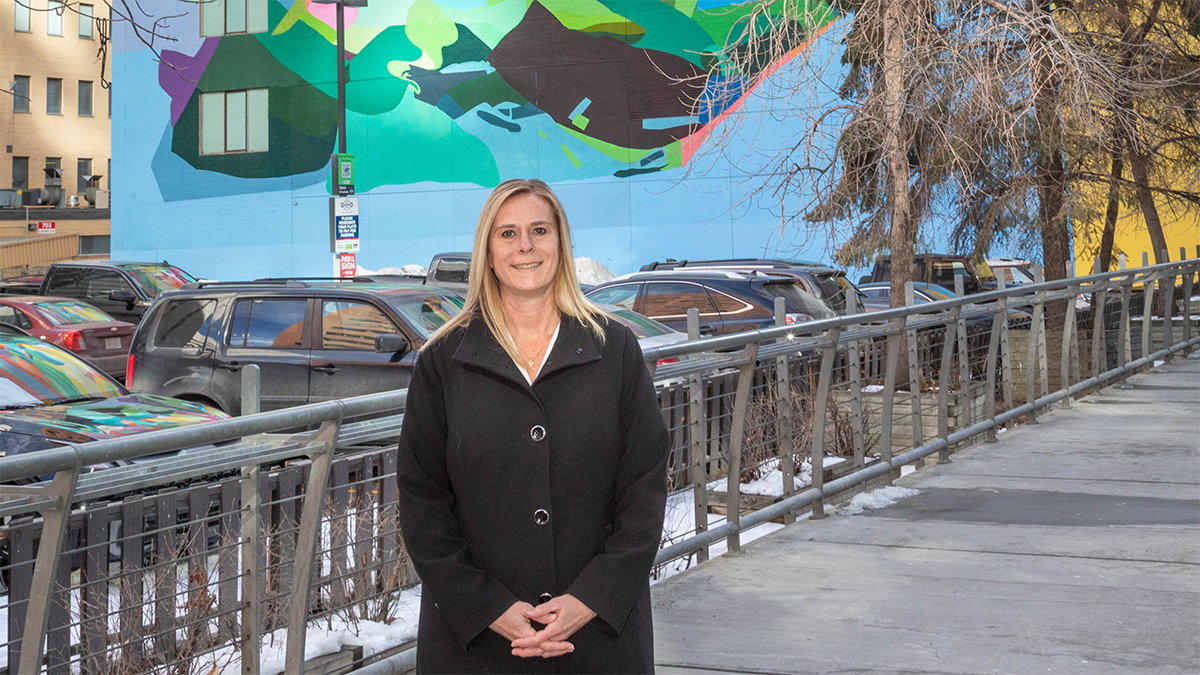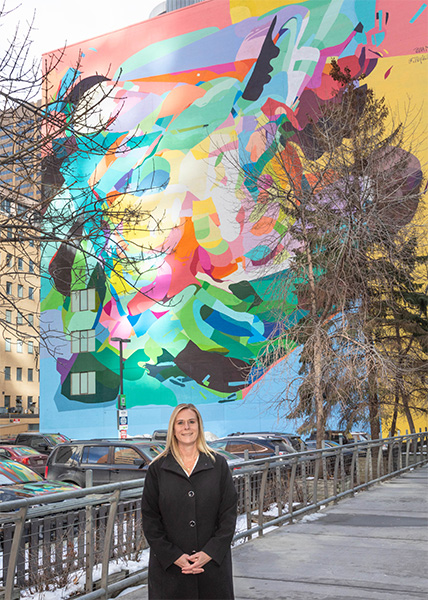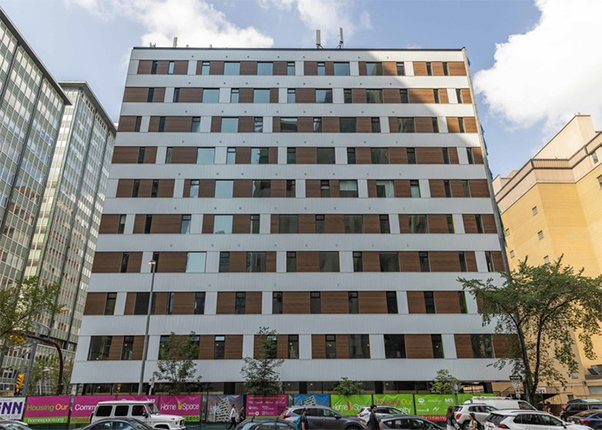No place like HomeSpace

Q&A with Bernadette Majdell of HomeSpace Society
HomeSpace Society is a nonprofit housing developer, owner and operator, with nearly 900 housing units serving vulnerable populations throughout the city. We sat down with HomeSpace’s CEO Bernadette Majdell to chat about some of their recent and current projects and the impact of affordable housing in Calgary.
Q: Tell us how Neoma came to life in Calgary’s Downtown.
A: We were in the middle of the pandemic and the federal government launched the Rapid Housing Initiative, which was funding targeted towards conversion or modular. We haven’t really done a lot of modular, so we were looking at conversions.
The easiest conversion at the time would have been hotels. Many were vacant because of COVID. Many hotel owners were trying to sell, and that led to, in my opinion, an untenable situation where nonprofits were competing and bidding up the costs. The other thing that was happening in Calgary was our office vacancy rate downtown was over 30 per cent. As an organization, we took a step back and said ‘What’s the right thing to do, not only for the people we serve but also the city we live in?’ so we started looking at office conversions.
Sierra Place (as the office building was called at the time) was in a prime location close to the C-train and had been sitting vacant for a couple years. It was the perfect storm where all these amazing elements came together. It so happened that some of the pre-work had already been done on the building, so we went to our board and said ‘This is what we want to do. We don’t yet have the money, but it’s the right thing to do and we feel like we can get the money’ and the board approved it.
Q: And you found financial support for the project?
A: The City of Calgary was first in, in terms of money to the project. This was even before The City’s Downtown Strategy was approved. The City demonstrated its commitment to doing the right thing for downtown, and from there we got the federal government, the provincial government, and we partnered with Inn from the Cold as our anchor tenant. That allowed us the ability to fundraise the difference after and gave us a product that was mortgage-free, which enables Neoma to be very deeply subsidized. We’re about 40 per cent below market for the rents in that building.
Q: Do you have an example of a resident success story from Neoma that you can share?
A: The best stories are really when residents move in. We had this one lady with her two kids, and when we showed them the apartment, she burst into tears and her kids were crying as well. They were a family from Ukraine and after going through trauma and moving to Canada, they didn’t believe that they’d get to live in a beautiful place that they could afford. I’m proud of Neoma in terms of how beautiful it is. When you have people who’ve experienced trauma see where they’ll be living, to me, that’s one of the biggest immediate impacts of housing.
Once people are safely and securely housed, then their life can start to change. If they’re not safely housed, if they’re afraid, if they’re worried, if they don’t know where their kids are going to sleep, then nothing can begin to change. Housing improves their lives, absolutely. And we have some residents who have now moved on to different locations.
Q: HomeSpace was selected to develop two family housing sites with City-owned land. Can you share some details about those two projects?
A: [When Council passed the Housing Strategy last September], there was an amendment made that focused two projects for emergency family housing. An open bid went out for all housing providers in the nonprofit sector to bid on. We are uniquely positioned because we are a specialized developer in affordable housing. One of the things that was a non-negotiable for The City was timeline. From signing the agreements to completion, we were looking at an 18-month timeline, which is tight. We put our best foot forward to be able to win these two projects because we think we’re best suited to deliver them on time and on budget in a market that desperately needs family housing.
Q: Neoma and those two developments focus on families experiencing homelessness. What other types of housing does HomeSpace provide in terms of different demographics?
A: HomeSpace was created to be able to serve the most vulnerable. That really ranges through the city, and it changes. When we did the community consultation for one of the family sites in February, one of the questions was “Can you tell me exactly who’s going to live here?” I said no because the families who are most in need today may or may not be the families who are most in need in 18 months. A lot changes in 18 months. What makes HomeSpace unique is that our housing can serve a variety of populations based on the critical need in the moment. We serve those exiting or experiencing homelessness, ranging from youth, families, women, singles. Some of our buildings are for a higher complexity in terms of individuals struggling with mental health, addictions, and physical health.
Most recently, the Downtown Safety Leadership Table completed its report and one of its recommendations supports one of our goals in the coming year, and that’s to find a site for high support, recovery-based, permanent supportive housing. That would be for our most visible unhoused in the Downtown core right now, who need incredible wraparound services and to be able to live with dignity. So that’s our newest project.
Q: What would you say is the biggest barrier to getting more nonmarket housing built?
A: It’s two-fold right now. One is money. Whenever we’re talking about nonmarket housing, money has to come from somewhere, whether it’s land, whether it’s funding, whether it’s donors. Especially in this environment with inflation and economic realities, we just can’t make the numbers work if there’s not money from somewhere.
The second barrier is community perception. With all of our community consultations, it comes down to not what product are we building, but who is living there. I’ve had some very difficult conversations, and we don’t shy away from the hard conversations. I can tell you no community has thrown a party when they heard HomeSpace is moving next to them. But people don’t understand who our residents are. They’re just people, and nobody knows what journey brought them to HomeSpace. All we know is that they need safe, affordable housing, and we think everybody deserves safe, affordable housing.
Q: Why are you personally passionate about housing, and what does home mean for you?
A: I’m from the Maritimes and where I grew up there wasn’t really visible homelessness. For us, when somebody fell on hard times, the community just rallied around them. That’s a different place, different time. For me, home has always been a safe space. To think that there are kids, families, women, uncles, brothers, sisters who don’t have a safe place to live because of what happened to them in their life signifies what’s wrong with society today. I think that we need to take care of our most vulnerable and that’s the part that I try to play in a small way at HomeSpace.

Did you know?
Neoma features Alberta’s largest outdoor mural on the west side of the building!

Neoma: An office-to-residential conversion project in Calgary’s Downtown. HomeSpace transformed the vacant office building into more than 80 units of affordable housing, as well as a childcare center, family shelter, and programming space, in partnership with Inn from the Cold. The renovated building opened in Fall 2022.
Modular: a type of construction where the home is built inside a home-building factory. Once complete, the modules (or components of these homes) are transported to a permanent location and assembled.
Rapid Housing Initiative: A federal government initiative that provides funding to support the rapid development of permanent, new affordable housing units.
Downtown Safety Leadership Table: Established in September 2023 by Mayor Gondek, a representative group of downtown leaders convened to identify barriers, opportunities, solutions, and strategies to address real and perceived safety issues in downtown Calgary.
Permanent Supportive Housing: a model that combines low-barrier affordable housing with social service supports to assist individuals in achieving housing stability.
Categories: Affordable housing

